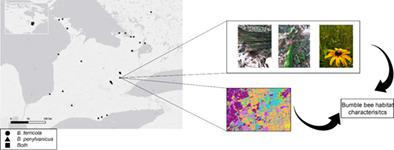当前位置:
X-MOL 学术
›
Insect Conserv. Divers.
›
论文详情
Our official English website, www.x-mol.net, welcomes your feedback! (Note: you will need to create a separate account there.)
One‐size does not fit all: at‐risk bumble bee habitat management requires species‐specific local and landscape considerations
Insect Conservation and Diversity ( IF 3.5 ) Pub Date : 2020-05-06 , DOI: 10.1111/icad.12419 AMANDA R. LICZNER 1 , SHEILA R. COLLA 2
中文翻译:

单一规格并不能全部满足:高风险的大黄蜂栖息地管理需要特定物种的本地和景观考虑
更新日期:2020-05-06
Insect Conservation and Diversity ( IF 3.5 ) Pub Date : 2020-05-06 , DOI: 10.1111/icad.12419 AMANDA R. LICZNER 1 , SHEILA R. COLLA 2
Affiliation

|
- Declining bumble bees are threatened by habitat loss, pathogens and climate change. Despite policy and management recommendations to create pollinator habitat, the habitat requirements for at‐risk bumble bees remains unclear. Most studies on bumble bee habitat are descriptive, focus on floral resources, occur at one spatial scale, or do not examine at‐risk species.
- We provide the first thorough habitat description for two North American bumblebee species (Bombus terricola and Bombus pensylvanicus) at‐risk of extinction. We asked the following questions: (i) What characterises B. terricola and B. pensylvanicus habitat? (ii) Are landscape variables, local variables, or flowering plant species more important determinants of habitat? (iii) do important variables change throughout the season?
- Surveys were conducted at 25 sites with a recent occurrence of either B. terricola, B. pensylvanicus, or both species across southern Ontario, Canada. Landscape variables were extracted from a 1‐km buffer around each site. Local variables related to bumble bee resource requirements (floral, nesting and overwintering) and flowering species cover were measured in spring, mid‐summer, and late‐summer.
- We found that the proportion of different land cover classes at 1 km was a more important predictor of B. terricola and B. pennsylvanicus presence than local transect based variables such as floral richness or the patchiness of floral cover. We did not find any evidence of important variables changing temporally, but floral resources were consistently important throughout the season. Our results highlight that management of at‐risk pollinator species requires consideration of species‐specific habitat requirements.
中文翻译:

单一规格并不能全部满足:高风险的大黄蜂栖息地管理需要特定物种的本地和景观考虑
- 下降的大黄蜂受到栖息地丧失,病原体和气候变化的威胁。尽管提出了建立传粉媒介栖息地的政策和管理建议,但对于有风险的大黄蜂的栖息地要求仍然不清楚。大多数关于大黄蜂栖息地的研究都是描述性的,着重于花卉资源,发生在一个空间尺度上,或者没有研究高风险物种。
- 我们提供了两种濒临灭绝的北美大黄蜂物种(熊熊和熊熊)的第一个详尽的栖息地描述。我们提出了以下问题:(i)特里克氏杆菌和戊型芽孢杆菌栖息地的特征是什么?(ii)景观变量,局部变量或开花植物物种是否是栖息地的重要决定因素?(iii)重要变量在整个季节是否发生变化?
- 在加拿大安大略省南部的25个地点进行了调查,这些地点最近都出现过B. terricola,B。pensylvanicus或这两种物种。从每个站点周围1公里的缓冲区中提取景观变量。在春季,仲夏和仲夏测量与大黄蜂资源需求(花,巢和越冬)和开花物种覆盖率相关的局部变量。
- 我们发现,与基于局部断面的变量(例如花的丰富度或花被的斑块)相比,在1 km处不同土地覆被类别的比例是B. terricola和B. pennsylvanicus存在的更重要的预测指标。我们没有发现任何重要变量随时间变化的证据,但是整个季节花卉资源始终很重要。我们的结果表明,对高风险传粉物种的管理需要考虑物种特定的栖息地要求。



























 京公网安备 11010802027423号
京公网安备 11010802027423号